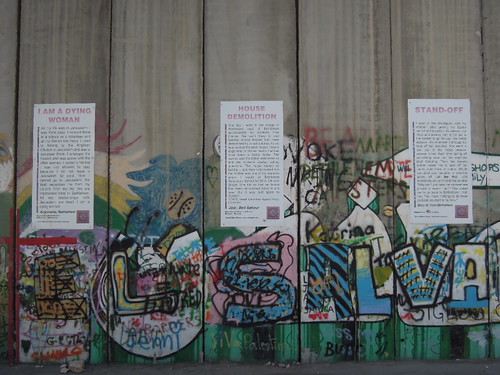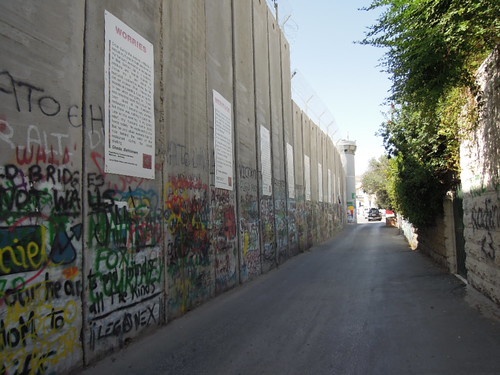Walking along the Wall can be depressing and inspiring, crushing and uplifting. On the one hand you can see how the Wall cuts through neighborhoods, how it divides people from their lands and their families, how it restricts movement. On the other hand the Wall is also an extraordinary display of resistance and persistence because you can see how people use it as a canvas for their hopes and dreams, covering it with drawings, writings, graffiti.
“After the Wall around Rachel’s Tomb was built, I felt terrible. Nobody was walking here, only the cats and dogs. The Wall creates a feeling… the feeling that it surrounds you; that you are not permitted to move. Every time, every day you see the Wall. When I look outside through the window to see the sunrise or the sunset the Wall is in front of me. When I go to the Wall I feel that something closes in on my heart, as if the Wall is on my heart.”
Melvina, Bethlehem
I don’t know Melvina, but I had the chance to get a glimpse into her life. Along with Maha, Rose, Antoinette, Sylvana, Ghada, Aida, Rana, and many more women she had the courage to share her experience on the Wall as part of the ‘Wall Museum’. On the Wall in Bethlehem around the Rachel’s Tomb area there is a series of posters that display true stories by Palestinian women. They tell the tale of Palestinian life under occupation. As the first poster explains, they are “stories of suffering and oppression as well as ‘sumud’ (steadfastness or resilience), inner strength and cultural identity”. This ‘Wall Museum’ is curated by the Sumud Story House, located just meters away from the Wall. Opened as part of the Arab Educational Institute in 2009, Sumud Story House is a place for women’s groups from the surrounding areas to come together for weekly meetings and social activities. One of the posters bears witness to the importance of these gatherings:
“The Wall is like a sign to say: “Go away from here”. It is intimidating. If you go from the checkpoint toward Gilo you can see all the land that was taken for its construction, and the land what we can no longer access. Some of the land had belonged to my grandparents. Despite everything, we must continue to resist. To continue with our daily life is a form of resistance. One example of resistance is coming every day to the Sumud Story House. The Israelis want to stop our lives by pushing us out. We can resist with any sign of life, and any activity helps, because activities make people want to stay here. You can organize a concert or another cultural activity. These are ways that we can reach the world and the world can reach us.”
Ghada, Bethlehem
Sumud stands for resilience or steadfastness despite facing challenges. This resilience applies to the stories displayed on the Wall as well as the project itself. When Sumud Story House opened in 2009, there was a very limited community life in the area. Hebron Road used to be the main street to get into Bethlehem from Jerusalem, with bustling shops and restaurants lining both sides. Since the Wall was built and the checkpoint established up the road, the area became desolate with businesses letting go of employees or having to close down. Rania Murra, the project coordinator, went from door to door to hear people’s stories and to invite women to come share their stories. Over the years, Sumud Story House has built an extensive network with women’s groups from different communities. Now four women’s groups meet regularly, in addition to a lot of regular cultural activities like a choir group, interreligious dialogues, and the annual Sumud Festival.
In each weekly meeting a different topic related to political, cultural, or social occasions is presented and discussed among the women. Through this community story telling approach, women can express themselves, are empowered in their rights, and can support each other in holding on to their hopes and dreams despite the reality of the Wall. Some of the stories told and collected in women’s groups were first put up in the meeting room in Sumud Story House. But soon the idea was born to present the stories to the public, locals and internationals alike. When the posters were finally installed in the Christmas time of 2011, women were happy to see their stories up on the Wall. “The women have faith and believe in their stories as Palestinians,” the general director of Arab Educational Institute Fuad Giacaman, whose wife authored one of the stories, reports, “Many women wanted their story to be seen. They want to communicate Palestine.” While the stories are there for everyone to seen, the organizers especially had international visitors in mind when designing the posters, selecting stories, and translating the narratives into English. “Many internationals come and take pictures of the Wall,” Fuad Giacaman explains, “Some know very little or nothing about what is going on here. Through the posters, they learn more.”
During a holiday in the region, many international visitors only do a day-trip to Bethlehem. After seeing the Church of Nativity and the Old Market, some come to see the Wall. But few have the time or the connections to talk to Palestinians living here. The stories allow people who don’t have the chance to get to know local Palestinians to nevertheless understand some of the challenges. “We often see humanitarian issues but don’t really comprehend the widespread personal consequences on the involved,” said Anky, a German girl visiting Bethlehem for one day: “Being at the Separation Wall for the first time, the posters of the Sumud Story House gave me an insight into the impact on personal lives this Wall has had.” Even for people who have a good understanding of the situation and the conflict, personal stories can often be the key to really comprehend the pervasiveness of the conflict, as Sarah, a foreign affairs student from the U.S. noted: “I’ve spent years studying the history of the conflict, the issues at stake, the wars, and the many attempts at peace negotiations. However, reading these stories helped me gain insight into the daily struggles and human rights abuses that Palestinians have faced under Israeli occupation. For them, the struggle is not only over borders and land and water, but the right to live their lives with freedom and dignity.”
Currently, AEI is planning to reinstall some of the posters that have fallen down but also to expand the “museum” with stories from its youth groups or to add posters debunking common stereotypes. “Often internationals come here with stereotypes of all Palestinians as suicide bombers and images in mind of women holding guns,” project coordinator Rania recounts, “We want to show the other side of the story.” Expanding the museum involves a lot of work, from collecting, translating, and editing the stories, to designing the posters and finally installing them onto the concrete Wall. To offset the cost of around $150 per poster, each story is picked and sponsored by individuals and organizations from around the world. Displaying more and more stories is also about sharing the Palestinian attitude, Rania explains: “We want to show Palestinians’ smile and strength. Even though their house gets demolished, they rebuild. Even though they live under occupation, they dance and laugh. Even though they cry, they smile.” Sumud – resilience despite challenges – is something that I have encountered over and over again when getting to know Palestinians. The ‘Wall Museum’ allows people who may only be in Bethlehem briefly to get a peek into this Palestinian way of life, where to rebuild, to meet, to sing, to laugh, to dance means to resist.
Posted By Mona Niebuhr
Posted Jul 25th, 2013




